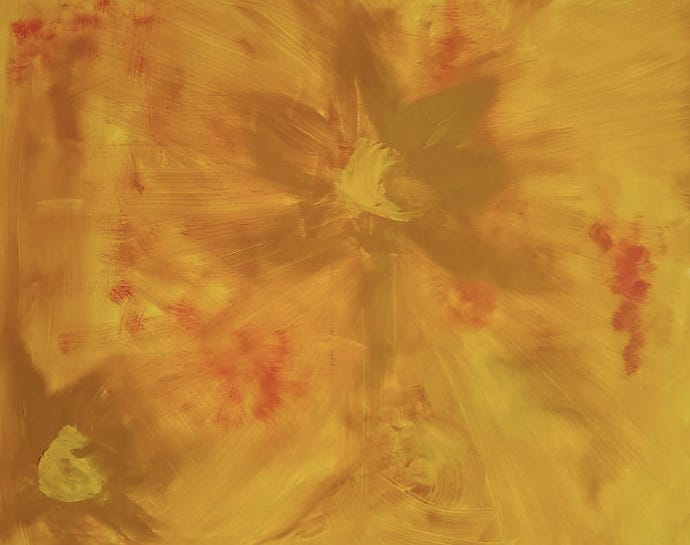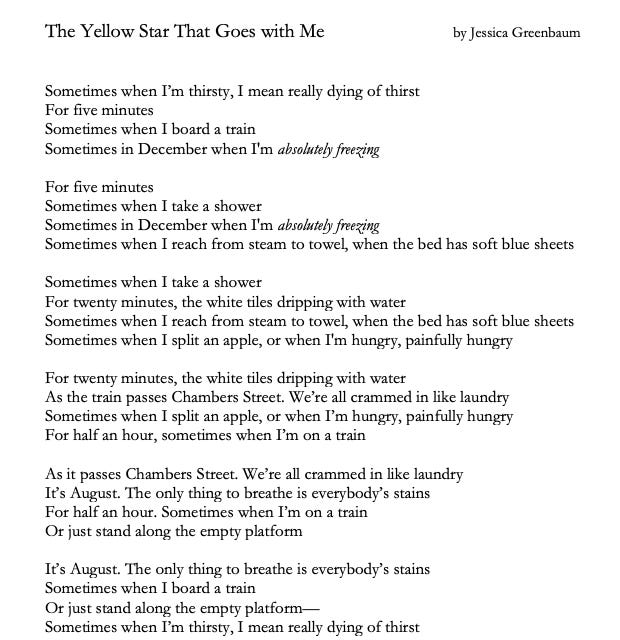From the moment Jessica Greenbaum’s poem ‘The Yellow Star That Goes With Me’* begins, withholding takes place, preparing the reader for the upcoming series of sentence fragments.
Greenbaum hints at the subject in the title (in the words ‘Yellow Star’) and in parts of the poem itself but never names it. While the poem centres around the Holocaust, and more specifically, the trains to and experiences in, the death camps, neither are openly acknowledged. Greenbaum is telling the story of the Holocaust by not telling it. Or rather, she is telling the story of a Jewish woman (the narrator) who is haunted.
This poem, a pantoum, is one of profound, even extreme, reticence. Greenbaum is not an avant-garde poet, but the post-modern movements, such as Language poetry, and their poets (such as Barbara Guest, Charles Bernstein, and Susan Howe) opened up possibilities for all contemporary poets, Greenbaum among them, to employ their radical strategies when needed. This is one of those strategies: a quick allusion to a subject without further development on that subject. The subject of the poem is only alluded to in the title with the reference to the ‘Yellow Star’. And the subject is touched on in some of the words: ‘train’, ‘shower’, and ‘steam’ and with the choice of the Manhattan subway stop ‘Chambers Street’ (this phrase may resonate subliminally in the reader as the gas chambers). The story at the poem’s centre is not articulated but only given a quiet glance, if at all. Rather, the poem is filled with fragmentary references to the speaker’s contemporary New York life of discomforts (‘thirst,’ ‘freezing’, ‘hungry’, ‘crammed’) and solaces (‘towel’, ‘soft blue sheets,’ ‘apple’). There is a slight sense of something horrible, although ‘dying of thirst’ is a common hyperbolic, even clichéd, way of referring to thirst in contemporary parlance as is the word ‘freezing’ when cold or the phrase ‘painfully hungry’. The poem surrenders to the failure of language.
Greenbaum’s poem suggests, through the aggressive absence of narrative and complete sentences, that what lies in the blank spaces is too terrible to name. Trauma lies in elisions, not in words. Poems written with such heightened narrative reticence (with the subject hidden and with unfinished sentences) alert us to what cannot be narrated, and to gaps that cannot be filled. Not naming the ordeal highlights it, draws attention to its pain as if it were an open wound that must not be touched.
The wounds are deep in the poem, the abyss is vast, and the information given is scant. Information, linear narrative, the expected sequence of events in the poem, are not only hidden from view, but the information and narrative snippets that do appear repeat themselves. As I mentioned above, Greenbaum’s poem comes in the form of a modified pantoum, a form that incorporates repetition of words and phrases. These repetitions block any sense of a logical sequence of events, which suggests no resolution, no way of rationally understanding the poem’s ‘story’. The poem distrusts sequences and logical order and leaves gaps and tears in the chain of events. Although Greenbaum introduces moments from the speaker’s life, snippets which reference an understory not spoken about (‘train’, ‘the only thing to breathe is everybody’s stains’, ‘dying of thirst’, ‘painfully hungry’, ‘Chambers’, ‘shower’, and ‘steam’), very little information about the speaker is given. And the fact that she can barely speak about the subject she alludes to points to her vulnerability, a sensitivity around the topic, and reveals very little. An empty space, an otherness is present in the poem.
This unknowing and vulnerability is brought out by the poem’s use of aposiopesis, a formal strategy wherein a sentence is deliberately broken off and left unfinished, giving an impression of an unwillingness to continue. This strategy has the capacity to create agitation. Aposiopesis is especially frightening. It raises questions: why can’t the narrator finish her sentences? What isn’t she saying? Is there something not being told that is too painful to bear? This breaking off from speech points to unfathomable areas we cannot and will never know.
[Painting: Yellow Star by Rebecca Hodel]
* The yellow star refers to the badges Jews were made to wear during various periods by Christians and Muslims. The badges marked the Jews as outsiders and were often seen as badges of shame. They are closely associated with Nazi Germany where they were often the prerequisite before the death camps.



